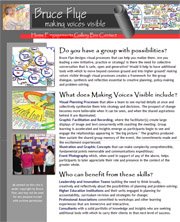I had never seen those steps illustrated like that before. Flip it over, add Mental Models and Vision, and the works of Daniel Kim and others have room to appear. Theory U is easy to connect with, especially as it comes from the same community of practice. Squint at it only a little and the Drexler/Sibbett Team Performance Model peaks back, taking one to Arthur M. Young’s Theory of Process. Buried in Young’s work are references to Thomas Kuhn’s Structure of Scientific Revolutions, a book loaned to me by a dean and a subject that recently keeps coming up in otherwise unre
 lated instances. The ICA’s Focused Conversation hangs on this framework nicely, too.
lated instances. The ICA’s Focused Conversation hangs on this framework nicely, too.Are these similar but otherwise diverse thoughts and processes, or are they one truth showing through different voices? Lori Arviso-Alvord spoke here in November and I noticed in her presentation many aspects of Navajo spirituality that sounded very much like things I have recently read on Buddhism. I had the good fortune to chat with her afterwards, and she said she, too, had noticed similarities between these very separate worlds. I immediately wondered if these separate worlds were in fact observing the same phenomena.
What might we make of all this, some sort of Unified Field Theory? Einstein passed without ever realizing his hopes for that in his discipline. Is there a unifying visual process that can be built here? Well, there’s already a Group Graphics Keyboard.
My current thinking is that there is other work to be done, and other questions to take up. What does Kenneth Boulding’s The Image add here – the suggestion that the bottom tip of the form is like the keel on a racing yacht? Is Appreciative Inquiry using that bottom as a starting point? Should we take Jeff Conklin's Dialogue Mapping as an indication that sequences cannot stand up to our innate tendencies? What
 tells us how deep to go, when and under what circumstances – Ron Heifetz’s Leadership Without Easy Answers? Or The Center for Creative Leadership’s GOLD Model? Where does the Osborn-Parnes Creative Problem-Solving Process fit in? Was Peter Block thinking about the difference between the right and left sides when he wrote The Answer to How Is Yes? Is this a way to get at double-loop learning as explained by Roger Schwarz? If we navigate the entire cycle, what makes it stick, what keeps us from backsliding?
tells us how deep to go, when and under what circumstances – Ron Heifetz’s Leadership Without Easy Answers? Or The Center for Creative Leadership’s GOLD Model? Where does the Osborn-Parnes Creative Problem-Solving Process fit in? Was Peter Block thinking about the difference between the right and left sides when he wrote The Answer to How Is Yes? Is this a way to get at double-loop learning as explained by Roger Schwarz? If we navigate the entire cycle, what makes it stick, what keeps us from backsliding?I’m thinking it’s like that story about the two little boys, where one was an optimist and the other a pessimist: there’s a pony in here somewhere!


No comments:
Post a Comment